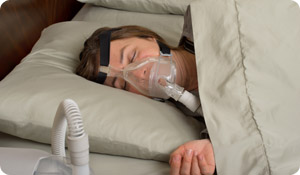
Do you (or someone you sleep next to) suffer from sleep apnea? This chronic breathing disorder, in which patients breathe shallowly or experience pauses in breathing, occurs while you’re asleep. Deep snoring is often the first sign, but not everyone who snores has sleep apnea.
The American Association for Respiratory Care estimates that up to 18 million Americans are affected by sleep apnea and approximately 10 million remain undiagnosed.
Signs and Symptoms
Since you are asleep when symptoms occur, you may not know you have sleep apnea. "Usually the first sign of sleep apnea is when a patient complains of not feeling rested when they wake up in the morning," says cardiologist William A Tansey III, MD, FACC, FACP, FAHA, of Summit Medical Group in Short Hills, NJ. "Then we start looking for other symptoms." Irregular heart rhythms, or atrial fibrillation, can also indicate sleep apnea, Tansey points out.
Alternatively, your first indication may be when a bed partner or someone in your household tells you they regularly hear a pattern of deep snoring, followed by a period of no snoring, then a gasp.
There are also other signs that you may have some type of sleep apnea:
- Getting up often throughout the night to urinate.
- Headache and sore throat or dry mouth upon wakening the next morning.
- No recollection of dreams. Sleep apnea interferes with REM (rapid eye movement) sleep, when dreaming normally occurs.
- Difficulty concentrating and experiencing feelings of depression, irritability, or other mood or personality changes during the day.
- Daytime sleepiness that interferes with your ability to drive or stay awake at work, or during other activities throughout the day.
The Risks of Sleep Apnea
Your sleep patterns have a potentially significant impact on your sense of wellbeing, as well as your behavior and performance while awake.
But sleep apnea is associated with more than feelings of exhaustion and crankiness. Several serious health problems are linked with the condition:
- Sleep apnea increases your risk for developing heart disease and stroke.
- Because sleep apnea can cause levels of oxygen in the blood to decrease, blood pressure may climb and atrial fibrillation (irregular heartbeat) may occur.
- Since people with sleep apnea may suffer from daytime sleepiness, they are at three times the risk of being involved in a motor vehicle accident.
- Children with sleep apnea may be at higher risk of attention deficit/hyperactivity disorder.
Types of Sleep Apnea
Obstructive sleep apnea, the most common type of sleep apnea, occurs when the airway is temporarily narrowed or blocked, usually by relaxed muscle tissue in the throat.
It is also possible to have mixed sleep apnea, a combination of both obstructive and central sleep apnea.
Are You at Risk?
Certain people are more likely to have sleep apnea; African-Americans, Pacific Islanders and Mexican-Americans are thought to be at higher risk than other groups. The risk of sleep apnea is higher in men than in women, affecting 4% of middle aged men and 2% of middle aged women.
About half of those diagnosed with sleep apnea are overweight or obese and half also have high blood pressure. Smoking, alcohol consumption, heart disease, diabetes, and metabolic syndrome (a collection of factors associated with a higher risk of heart disease, diabetes and stroke; these include excess fat around the waist and low HDL, or "good" cholesterol levels) are also linked to sleep apnea.
"Sleep apnea is very commonly associated with overweight because of the extra 'upholstery' in the patient’s throat," says Tansey. "I often suggest a weight loss program for relief of sleep apnea symptoms."
The risk is higher in older people than in younger, and higher in those with a family history of the condition. But sleep apnea can also affect children. Small airways in the nose, throat, and mouth can be responsible for sleep apnea, as can enlarged tonsil tissue in the throat of a child.
Treatment
If a medical condition is causing sleep apnea, the ideal solution is to treat the underlying problem—like excess weight, for example—in order to resolve the apnea. If medication (like a narcotic) is the cause, a physician may be able to lower the dose. At the same time, medications that stimulate breathing may be prescribed.
Breathing devices worn during sleep are often recommended for most types of sleep apnea. These include devices known as CPAP (continuous positive airway pressure), BiPAP (bi-level positive airway pressure) and ASV (adaptive servo-ventilation). Each of these systems works in a slightly different way to ensure airflow into the airway or prevent muscle collapse that blocks breathing. In some milder cases, treatment can include dental appliances that help prevent snoring. In some unusual cases, surgery may be indicated.
William A. Tansey III, MD, reviewed this article.
Sources
William A Tansey, MD. E-mail message to author. November 21, 2014.
"Sleep Apnea Facts." American Association for Respiratory Care. 2014.
"What is Sleep Apnea?" National Heart, Lung, and Blood Institute. Last modified July 10, 2012.
"Sleep Apnea." National Sleep Foundation. Page accessed December 29, 2014.
"Pain Medication--Narcotics." MedlinePlus/National Institutes of Health. Page last updated May 13, 2013.
"What Is Metabolic Syndrome?" National Heart, Lung, and Blood Institute. Page updated November 3, 2011.





